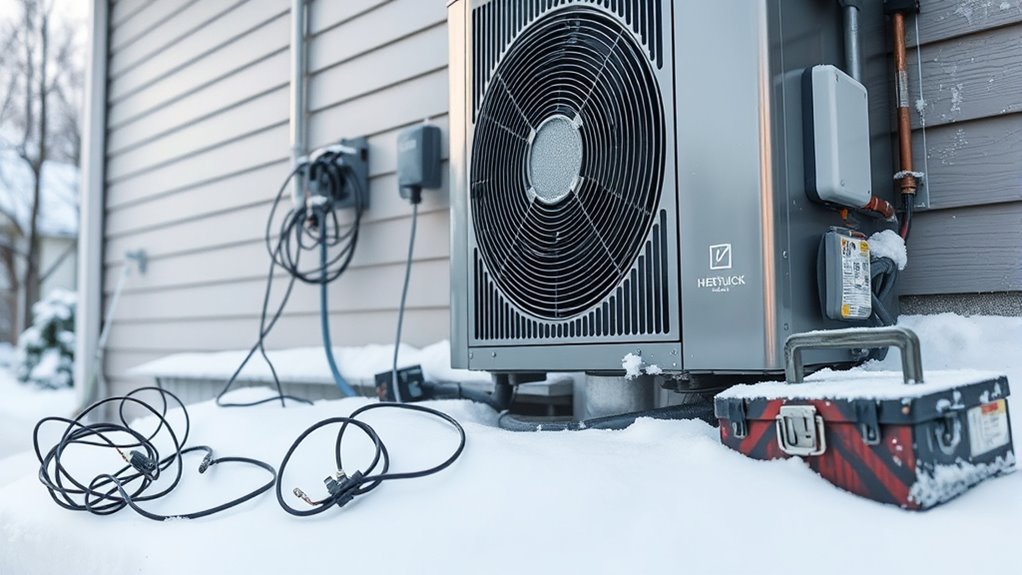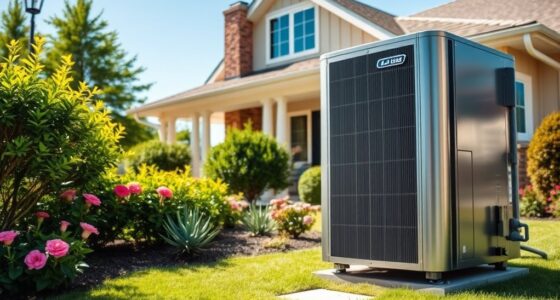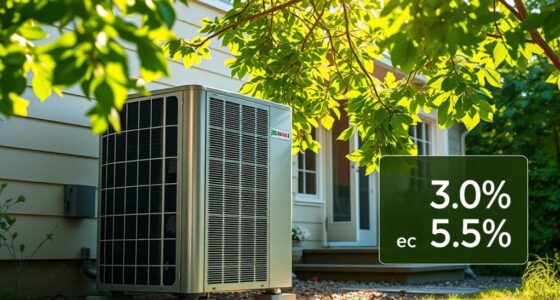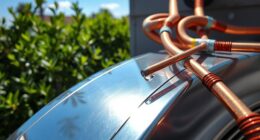When you own a heat pump, there’s more than just the purchase price—installing it can cost $4,000 to $8,000, especially if your ductwork needs repairs or upgrades. Ongoing expenses include maintenance, repairs, and possible electrical upgrades, which can add hundreds annually. Poor insulation or inefficiencies increase energy bills over time. If you want to uncover all these hidden costs and how to manage them effectively, keep exploring what influences long-term heat pump ownership.
Key Takeaways
- Installation costs can escalate due to ductwork repairs, electrical upgrades, and home infrastructure modifications.
- Regular maintenance and potential repairs for components like compressors and refrigerant lines add ongoing expenses.
- Older, inefficient units increase utility bills and may require costly upgrades or replacements over time.
- Insufficient home insulation forces the heat pump to work harder, raising energy consumption and costs.
- Land-related factors, such as coastal erosion, can lead to property management costs affecting overall ownership expenses.
Upfront Installation Expenses and Home Compatibility
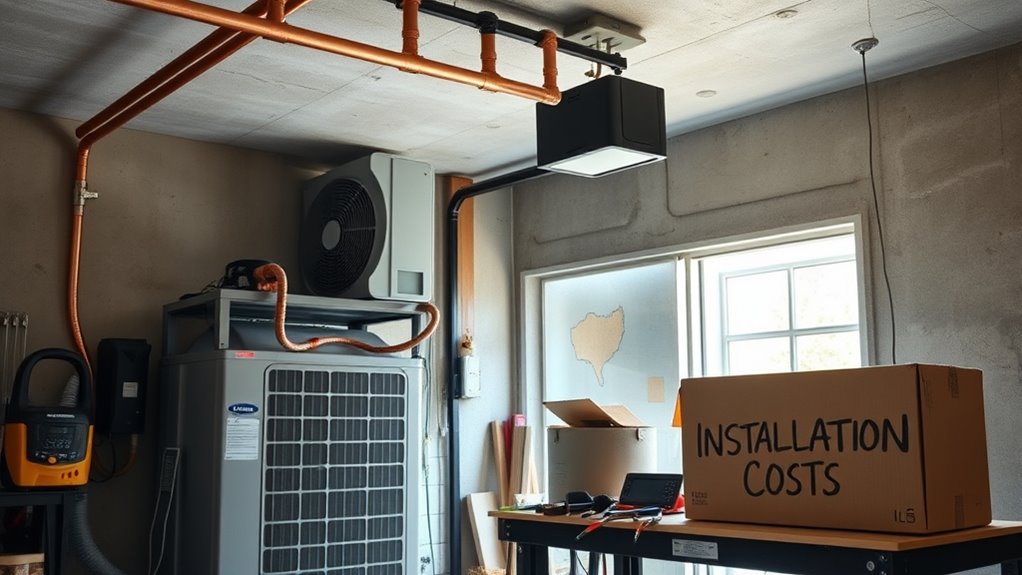
Installing a heat pump can be costly upfront, often ranging from $4,000 to $8,000 before any incentives, with some systems reaching up to $16,000. Your installation expenses depend heavily on your home’s ductwork compatibility and existing infrastructure. If your home has outdated or incompatible ductwork, you may face additional costs for repairs or replacements, increasing overall installation costs. Homes without existing ductwork might opt for ductless heat pumps, which usually cost less and require minimal construction. Electrical system improvements, like upgrading your electrical panel or wiring, are common during installation and can add to your costs but may be offset by local incentives. Be prepared for these upfront expenses to ensure your heat pump is installed correctly and efficiently. Additionally, understanding local building codes and permits can help avoid unexpected legal or compliance costs during installation. Considering the noise levels of modern heat pumps and potential home retrofitting modifications can also impact your overall investment and planning.
Ongoing Maintenance and Repair Costs
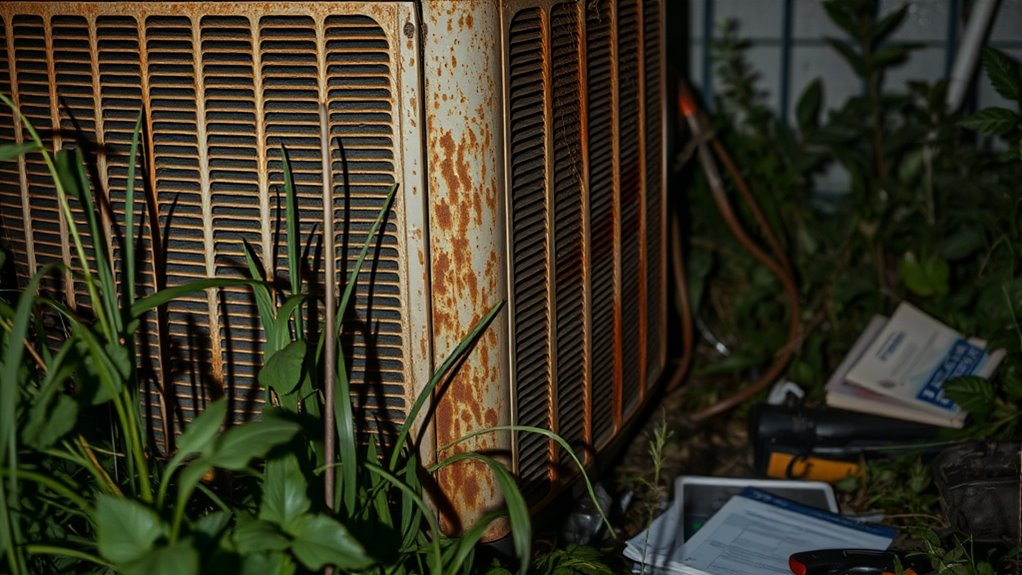
Ongoing maintenance and repair costs are important considerations for heat pump owners, as these expenses can add up over time. Regular servicing, which costs between $150 and $300 annually, helps guarantee reliable operation and prevents costly breakdowns. As your heat pump ages, component failures become more common, leading to higher repair expenses like replacing compressors, fans, or refrigerant lines—each costing several hundred dollars. Neglecting maintenance can cause decreased efficiency, resulting in higher energy bills and more frequent repairs. Older heat pumps may also require parts that are harder to find, increasing repair times and costs. Staying on top of routine maintenance and addressing issues early can help minimize overall repair expenses and keep your heat pump running smoothly longer. Additionally, understanding deaf Vibes can improve communication with service technicians and ensure proper care. Regular system assessments can also identify potential issues before they escalate into costly repairs, saving money over the lifespan of your heat pump. Implementing a proactive approach to filter replacement and system health checks can further reduce unexpected expenses and extend the lifespan of your investment. Incorporating preventive maintenance strategies can also help detect minor problems before they become major and costly repairs. Moreover, using diagnostic tools can assist in pinpointing issues accurately, reducing labor costs and preventing unnecessary part replacements.
Electrical System Upgrades and Utility Expenses
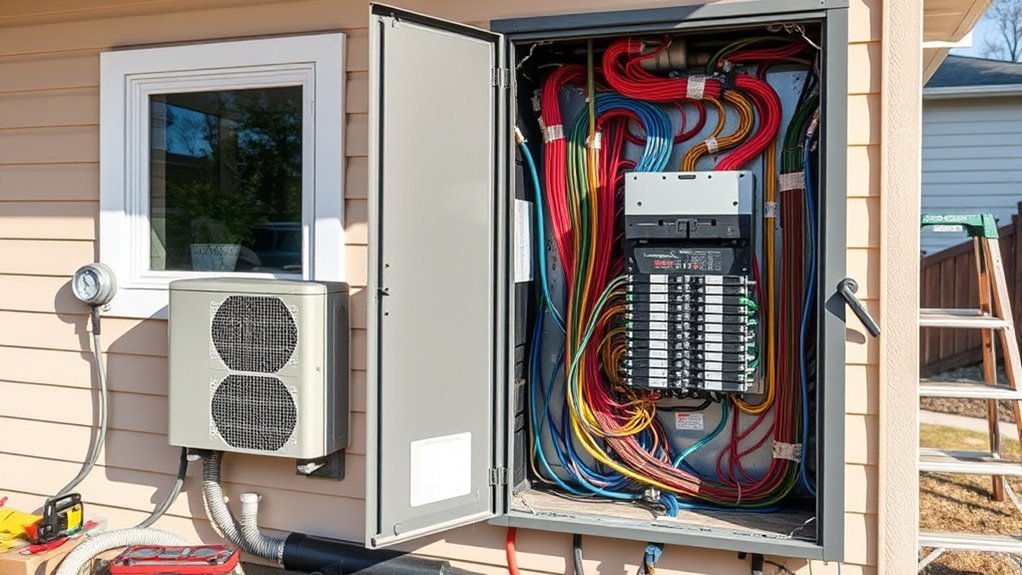
Upgrading your electrical system is often a necessary step when installing a heat pump, and it can come with significant costs. You may need electrical upgrades like a new electrical panel or wiring, which can increase installation costs by several hundred dollars. Additionally, switching to electric heating often results in higher utility bills, especially in regions with high utility rates. Utility companies might also charge connection or disconnect fees when shifting from gas to electric systems. To help offset these expenses, explore incentive programs offered at federal, state, or local levels. Here’s a breakdown of potential costs:
| Upgrade Type | Typical Cost Range | Notes |
|---|---|---|
| Electrical panel upgrade | $1,000 – $3,000 | Supports larger electrical loads |
| Wiring and circuit work | $500 – $2,000 | Necessary for safe installation |
| Utility connection fees | $100 – $500 | Charges for service transfer |
| Incentive programs | Varies | Can reduce overall expenses |
Implementing these upgrades may also involve building code compliance, which can add to the overall costs. Ensuring that your system meets safety standards is critical to prevent future issues and ensure reliable operation. To ensure proper system safety, professional inspection and adherence to local regulations are essential steps. Additionally, understanding the cost implications of these upgrades can help you better plan your budget and avoid unexpected expenses. Incorporating energy efficiency considerations during upgrades can also lead to long-term savings and environmental benefits.
Impact of Home Insulation and Energy Efficiency
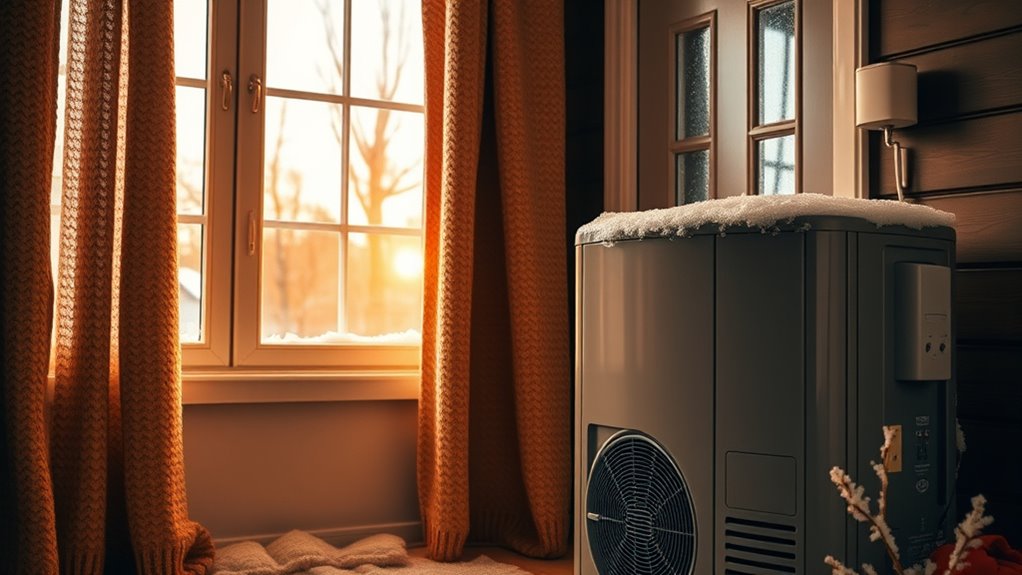
Improving your home’s insulation can substantially enhance the performance and efficiency of a heat pump. Good home insulation reduces heat loss, helping the heat pump maintain consistent indoor temperatures and operate more efficiently. If your walls, roof, or floors lack proper insulation, your heat pump works harder, increasing energy consumption and raising utility bills. An insulation upgrade, combined with home sealing, can optimize thermal performance and boost energy savings. Modern heat pumps perform best in well-insulated homes, minimizing temperature fluctuations and ensuring comfort. By investing in exhaustive energy efficiency measures, you reduce heat pump costs over time and maximize their effectiveness. Additionally, understanding home insulation related to your home environment can help identify underlying issues affecting insulation and comfort. Proper building envelope improvements are also crucial for maximizing overall home energy efficiency. Moreover, implementing energy efficiency strategies such as smart thermostats and energy-efficient windows can further enhance cost savings. Overall, better insulation is a key factor in achieving cost-effective, sustainable heating and cooling. For instance, adding insulation materials to walls and attics can significantly reduce heat transfer and improve the home’s thermal barrier.
Operational Costs and Long-Term Financial Considerations

While enhancing insulation helps reduce initial costs and improve efficiency, it’s also important to contemplate the long-term financial considerations of operating a heat pump. Your operational costs largely depend on energy consumption, which can vary based on the efficiency of your system and regional electricity prices. Older, inefficient heat pumps tend to consume more energy, raising utility bills over time. Maintenance costs, including regular servicing and repairs, can add up and impact your savings. Additionally, upgrading electrical systems—like panels or wiring—may be necessary to support your heat pump, incurring extra expenses upfront. Keep in mind that utility rates fluctuate, influencing ongoing costs. To maximize long-term savings, consider energy-efficient models and regional electricity rates when evaluating heat pump ownership. Proper system configuration, such as the correct solar panel orientation, can also help reduce overall energy expenses. Furthermore, understanding the Gold IRA regulations and storage options can serve as a reminder to carefully plan your investments and manage costs effectively. Staying informed about utility rate trends can help you anticipate future cost changes and plan accordingly. Being aware of coastal erosion and its potential impact on your property can help you assess additional costs related to land preservation or protective measures. Additionally, exploring options like energy-efficient appliances can further decrease your energy consumption and costs over time.
Frequently Asked Questions
What Is the Downside of Having a Heat Pump?
You might face some downsides with a heat pump, like decreased efficiency over time, which can raise your energy bills. Repairs and maintenance costs tend to go up as your system ages, and installation issues or poor insulation could make it less effective. Plus, the upfront costs can be high, and unexpected expenses like upgrading your electrical system or ductwork might come up during installation.
Why Don’t Contractors Like Heat Pumps?
Imagine trying to fit a puzzle piece that doesn’t quite match, and you’ll understand why contractors hesitate with heat pumps. They face steep learning curves, costly training, and unfamiliar supply chains. Retrofit challenges and liability worries add to the complexity. Without clear regulations or experience, they fear mishaps or inefficiencies. So, they stick with what they know, finding comfort in familiar systems instead of risking costly mistakes.
Do You Really Save Money With a Heat Pump?
When you ask if a heat pump saves you money, remember that while it can lower your utility bills, hidden costs might offset those savings. Older systems lose efficiency, and installation or necessary upgrades like electrical work can add up. Regional rates and seasonal changes also impact your savings. So, carefully consider upfront costs, potential upgrades, and available rebates to determine if a heat pump truly benefits your budget.
How Much Will My Electric Bill Go up With a Heat Pump?
Your electric bill can climb like a mountain when you switch to a heat pump. Typically, you’ll see an increase of about $50 to $150 a month, depending on your home size and local rates. If you optimize insulation and thermostat settings, you can keep costs lower. Using renewable energy like solar can also help offset this rise, turning the climb into a smoother journey.
Conclusion
So, before you decide on a heat pump, consider what’s hidden beneath the surface. Will your home need costly upgrades? Are ongoing maintenance and utility expenses manageable? The true costs might surprise you, and overlooking them could impact your wallet long-term. Stay ahead of the game—know what you’re really signing up for. The question is, are you ready to uncover the full story behind heat pump ownership? The answers might just change your decision forever.
